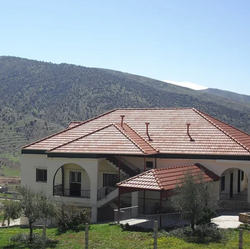Mdoukha
Mdoukha
مدوخا | |
|---|---|
Village | |
 | |
| Country | |
| Governorate | Beqaa |
| District | Rashaya |
| Area | |
| • Total | 5.86 sq mi (15.18 km2) |
| Elevation | 3,261 ft (994 m) |
Mdoukha (Arabic: مدوخا) is a village and municipality situated 72 kilometres (45 mi) east of Beirut in the Rashaya District, Beqaa Governorate, Lebanon.[1][2] The village's population is Sunni. A significant majority of the population are also Lebanese Canadians, of which 60% live in London, Ontario.[3]
Mdoukha lies in the Beqaa Valley, about 15 Km northwest of Mount Hermon, 70 Km from the capital Beirut and lies 1150 m above sea level.[citation needed] Villages that surround Mdoukha are Kherbet Rouha, Ayn Araab, Al-Berih, Bakka, Al-Rafid and Kfardenis.[citation needed]
Mdoukha has a few natural and historic destinations. On top of Mdoukha's tallest mountain, there is a castle that dates back 8000 years ago.[citation needed] Mdoukha's population is approximately 3300 people.[citation needed] Mdoukha's family names include: Abdo, Abdulhamid, Abdulkarim, Assaf, Birani, Borhot, Chahbar, Chams, Hage, Hammoud, Jambein, Meddoui, Merhi, Moussa, Elnazali, Omar, Soufan, Zabian, Youssef.
Mdoukha, one of the most beautiful villages in the Rachaya District of Lebanon. It lies in the Beqaa Valley, about 15 Km northwest of Mount Hermon, 70 Km from the capital Beirut and lays 1150 m above sea level. Villages that surround Mdoukha are Kherbet Rouha, Ayn Araab, Al-Berih, Bakka, Al-Rafid and Kafardenis. Mdoukha's Population : 3300 people and 60% of them live in Calgary Alberta Canada . With modern architecture and the building of new home, Mdoukha never lost its historical image represented by the old houses. Mdoukha's Family Names : Abdulkarim, Assaff, Birani, Borhot, Chahbar, Chams, Elkhateb, Hage, Hammoud, Jambein, Meddoui, Merhi, Moussa, Elnazali, Omar, Soufan, Zabian and Youssef. Alternate name for Mdoukha is Jebel Kassir also was the birth place of Sleiman Moussa one the best men to live in Mhdouka.
References[]
- ^ George Taylor (1971). The Roman temples of Lebanon: a pictorial guide. Les temples romains au Liban; guide illustré. Dar el-Machreq Publishers. Retrieved 23 September 2012.
- ^ Université Saint-Joseph (Beirut, Lebanon) (1968). Mélanges de l'Université Saint-Joseph. Imprimerie Catholique. Retrieved 24 September 2012.
- ^ "The Monthly - issue 91" (PDF). localiban. p. 7. Archived from the original (PDF) on 4 March 2016. Retrieved 25 December 2015.
External links[]
- Populated places in Rashaya District
- Populated places in Lebanon
- Sunni Muslim communities in Lebanon
- Archaeological sites in Lebanon
- Roman sites in Lebanon
- Tourist attractions in Lebanon

